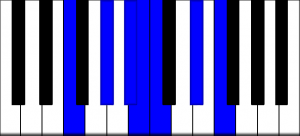In addition to playing blues licks, being able to apply the blues scale and play it fluently over a left-hand pattern is essential for your blues piano soloing.
The blues scale on the piano
As a first step, familiarize yourself with the blues scale. It consists of the root, minor third, fourth, sharp fourth (or flatted fifth), fifth and minor seventh of any given key. Another way to memorize the blues scale is to play a minor seventh chord and add the fourth and sharp fourth.
Here are the notes of the blues scale in the key of F.

The F Blues Scale

The blue note in soloing
In addition to the flatted seventh which also characterizes the dominant and minor seventh chords, the so called blue note or sharp fourth is what gives blues and jazz its special flair.
The interval between the root and the sharp fourth (in this case between F and B) is called the tritone. Its dissonance is a basic element of blues and jazz. It creates a tension that – if applied properly – will give you just the right sound! Because of its tension, it is played mostly as a passing note or ornament in soloing.
To get started with playing the blues scale over left-hand blues patterns, you can play this simple exercise to coordinate the hands. The notes of the blues scale are played over a 12 bar blues in the key of F with the left hand playing a shuffle rhythm.

The notes of Pattern 1 just move down the blues scale starting on F. Pattern 2 starts on the root F as well, but moves down again after reaching the minor third Ab, and then moves down to Eb and back to F.
